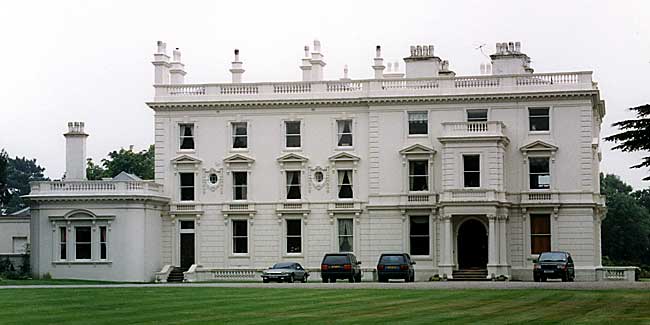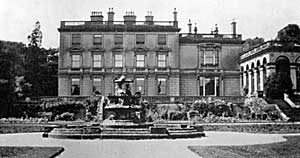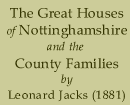< Clumber | Contents | Flintham >
Colston Bassett

Colston Bassett hall was built c.1704 but was remodelled in the mid-19th century (photo: A Nicholson, 2003).
THE manor of Colston Bassett, which is situated in the Southern Division of this county, has been in the possession of several different families. It is perhaps absolutely certain that no family ever held it so long as the Bassetts, who were its lords more than seven hundred years ago, and who had property in the county for generations afterwards. When Stephen was King, Ralph Bassett, after whom this place is named, filled the highest judicial office in the State, and his career furnishes an instance of judicial severity which has probably no parallel in the records of judges’ sentences. At an Assize held in Leicestershire he is said to have convicted capitally fourscore criminals, and to have condemned six others to undergo the most horrible forms of torture. Perhaps it was in atonement for this extraordinary severity that, later in his life, he gave a strip of land and ten fat oxen for the maintenance of a Monk in an Abbey situated in another part of England. But this attempt to gain a reputation for piety and benevolence did not secure Judge Bassett against the influence of public opinion, and it was darkly asserted that this exalted official had condemned people to death and torture in order that he might enrich himself by their forfeitures. Ralph Bassett’s son was also a judge, but his legal career, so far as I know, furnishes no extraordinary incident. For generations the Bassetts held Colston, and it is said that one of them was successful in procuring a grant from Edward the First establishing a market and fair in the village. During the sovereignty of Richard the Second Colston Bassett passed into the hands of the Dukes of Buckingham, and by them it was held until the reign of Henry the Eighth, when it was again sold. The Hon. Mrs. Kay, sister to Lord Strafford, was in possession of the estate at the end of last century, and dying abroad left it by will to the late Mr. Henry Martin, M.P. for Kinsale, and afterwards Master in Chancery. He died in 1839, and was succeeded by his second son, Mr. H. B. Martin, who sold the estate in 1864 to Mr. G. B. Davy, of the firm of Anthony Gibbs and Co., the eminent London merchants. This gentleman died in 1874, and his son, Mr. G. B. Davy, disposed of the greater part of the estate to Mr. Robert Miilington Knowles, a gentleman belonging to a Lancashire family, who now resides at the Hall.
The late Mr. Davy was a great gardener. He built a small village of glass houses, and he spent vast sums of money in perfecting orchids, a floral luxury for which his gardens were famous. He built a house for his bead gardener which in a town would be considered large enough to accommodate a tolerably influential family, and he employed some twenty men to attend to the work of his conservatories and pleasure grounds. Mr. Davy also took a great interest in cricket, and he had made, close to his house, a very fine cricket ground, a task which, looking at the somewhat uneven formation of the park and grounds and the character of the land, must have involved a very large expenditure of money. The stove-houses were certainly among the finest in the county, and the rare and beautiful things which they grew were famed beyond the limits of this shire. Mr. Knowles, although his tastes and aspirations do not run in the direction of orchids, keeps this part of the garden in excellent order. You may see in the houses that once were consecrated to the growth of the pampered children of horticulture, a collection of fine showy plants, and ferns, and hothouse products, sufficiently rare to show that scientific gardening is not neglected, and certainly sufficiently beautiful to indicate the existence of excellent taste on the part of those to whom they belong. Then there are great glass houses where grapes are grown, and where delicious fruits are brought to perfection, as was the case in the time of the great orchid grower. In-door gardening so far from being a lost art at Colston Bassett, is carried on with systematic attention, with constant care, and with unquestioned skill. Much of the work out of doors is done under the instructions of Mrs. Knowles, who has directed her attention to the opening up of vistas, and to the removal of growths which have marred the landscape or interfered with the view. Small shrubs or trees, and even larger specimens, which have got out of place, spoiling the effect of their finer and more leafy brethren, or interfering with the prospect, have good cause to tremble to their very roots if they should be unfortunate enough to attract the attention of the lady of the house, who has not only ordered a quantity of timber near the hall to be hewn down and cast into the fire, but has also caused to be removed from their native soil to a fresh locality, other trees which, in her opinion, have been out of place. Near the house there is a very fine row of yews, supposed by the late Mr. Veitch, of Chelsea, to have been planted 600 years ago, the effect of which is somewhat marred by the obstructive influence of a number of smaller trees of the same class. The obstructives are to be taken up and placed like so many naughty children at the back of their elders, whose proportions they are now hiding from view. Mrs. Knowles has effected many improvements of this kind, and several very pretty bits of pleasure-ground scenery have been brought to light and sight under her dynasty.
As to Mr. Knowles, he perhaps spends much of his time in solving the farming difficulty. He takes considerable interest in his firm, which is within a convenient distance of the house. He has a large flock of sheep of the famous Shropshire breed, and has taken a number of leading prizes from the sheep classes of several of the agricultural shows—the Royal amongst them. He has some 500 acres of land in cultivation, and he farms it on the best principle. At his farm most of the work is done by means of machinery, moved by steam, even to the drying of wet hay. The stacks are, most of them, under long metal roofs, raised by substantial supports, an arrangement which saves the trouble and expense of thatching, which in these days is often so imperfectly done. If the hay be wet there is a machine for drying it, the moisture being removed and carried away in the form of vapour by means of a fan. The arrangement is perfectly simple, and Mr. Knowles tells me it is so effectual that this last season his hay crop was in no way spoiled by the wet. Mr. Knowles is a constant follower of the chase, and with first-rate hunters in his stables, four packs of hounds meeting within reachable distance of his residence, and plenty of time on his hands, he has ample opportunities of indulging in a pastime which is perhaps even more to his taste than that which he followed more frequently some years ago, when he was master of one of the oldest packs of harriers in the country.
The hall and the church at Colston Bassett are removed from the village. The former has stood the test of time remarkably well; the latter is the older of the two, and some would say that the time had come when it might with advantage be placed in the hands of the restorers. The church, which stands on an eminence on the verge of the park, was built and endowed by the Abbey of Laund in Leicestershire, and competent authority has fixed its date at about 1293, though it was evidently built on the site of an older church, the Norman pillars of which remain. It was a cruciform building, with north and south aisles and transepts, but the north aisle and north transept were taken down just a century ago, the authorities of that time considering it too large for the limited requirements of the parish. Three of the five sweet-toned bells have quaint pre-Reformation inscriptions on them. On the one of the date 1606 there is this couplet—
My roaring sound doth warning give
That men here cannot always live.
The other two inscriptions are in Latin. In former times part of the village surrounded the church, and in very dry seasons the foundations of houses may be traced. In a map of Queen Elizabeth’s time, still in existence, the names of the occupiers of the dwellings may be found. In all probability the village was much more populous than it is now, but when the Fosse road ceased to be the principal artery in this part of the county, the villages in the district became less populous. In the year 1604 the village was visited by a terrible plague scourge which destroyed a number of the inhabitants and spread alarm throughout the whole district. In presenting these facts I ought to say that my own observation has been very much aided by certain information very kindly furnished me by the Rev. Joshua Brooke, who succeeded his father in the incumbency, which be had held since 1800.

Colston Bassett Hall, c.1940.
The hall has been altered by successive owners. For instance, the entrance, which was formerly on the south side, is now on the west. From the windows on the south you now look down a fine grove of frees, planted in 1710, and overshadowing what is called the Lord’s Walk. The front part of the house looks towards the village, which, however, is hidden from view. The most important internal improvement made by Mr. Knowles is to be observed in the drawing room, which has been extended so as to take in a smaller apartment. This is a long elegant room, full of pretty furniture, and bright with growing ferns and flowers. The walls are liberally covered with water-colours, and the room well supplied with pretty things, among them valuable china vases, and some elegant stands of Indian workmanship. Amongst the water-colours is one larger than the rest, “The Letter Writer,” which has attracted such attention that Mr. Knowles was asked to send it to the Philadelphia Exhibition. He allowed it to go across the water, along with a magnificent watercolour by Louis Haghe, which now hangs in the morning room, and is perhaps the best picture in the whole of Mr. Knowles’ collection. It represents a Cardinal Mass in the Sistine Chapel, in all the rich colouring and impressive detail which are associated with such a ceremonial. At the back of the altar rises the grand fresco of Michel Angelo, the figures in that masterpiece being faithfully reproduced. The floor of the chapel is thronged with people, some in an attitude of prayer, but the majority standing, while three people kneeling at the altar are receiving some rite at the hands of the priests. The picture is a masterpiece of its kind, and, I am told, it attracted a good deal of attention at the Philadelphia Exhibition.
The whole of the pictures at Colston Bassett are modern. Most of them have been bought by Mr. Knowles from the walls of the Royal Academy at different exhibitions. The majority of them are hung in the dining room and billiard room. Amongst the Academy pictures are two by Mr. G. A. Storey—” Little Swansdown” and “The Blue Girls of Canterbury “—a picturesque procession of girls in the clean, comfortable garb of the institution to which they belong, a work which I remember having seen on the walls of Burlington House. The fine picture by Mr. Ansdell, R.A., where the painter shapes out in firm drawing and truthful colour his conception of Burns’ “Poor Mailie,”
“Now, honest Hughoc, dinna fail
To tell my master a’ my tale,
And bid him burn this curs’d tether.”
This said, poor Mailie turn’d her head,
And closed her e’en amang the dead,
which tells a pathetic tale of the sufferings of an unfortunate sheep, was likewise purchased from the Royal Academy collection, as also were “The Charcoal Burners,” a very fine picture by Beavis, “In the Haunted Chamber,” by Mr. Yeames, an Academy associate, supposed to represent a certain mysterious chamber at Belvoir Castle, though I never knew of’ the existence of such an interesting apartment; a room in Hadden Hall, by Escusarer, painted on panel; Frith’s “English Flower Girl,” and two very fine landscapes by James Linnell. One of these represents a panic in a hayfield caused by the sudden breaking of a thunderstorm. A thin streak of forked flame has just pierced the dark metallic clouds in the background, two women at work in the field have hastily quitted their labour and. are snatching their babes from the sweet scented hay on which they bad laid them for safety, and among the male workers there is manifest that sense of alarm which sometimes possesses people when Nature’s artillery is practising. This perhaps would not have a place among the six best pictures in the house, but it is a stirring painting, and one that solicits a close inspection. Among that favoured six, a strip of the sea which beats on the Kentish coast, by T. Webster, would certainly have a place. The water is alive, and. the crest of one big wave shows that peculiar transparency which is seen the moment before it breaks into foam. In the billiard room is a small picture—one of those blood-red sunsets, which travellers tell us are peculiar to the East, which is worthy of mention, apart from any claims its artistic merit may have. On the back is an inscription which tells that the picture was presented to the late Charles Dickens in 1850, by Roberts, the artist, as a mark of respect for his talent and worth, and in one corner appears the peculiar autograph of the novelist, so that in all probability the picture was formerly at Gad’s Hill. I noticed also in the billiard room, associated with the English artists, a good example of the style of the American painter, Bradford, (“ The Wrecked Emigrant Ship.”) who numbers among his patrons the Queen and the Duke of Sutherland.
